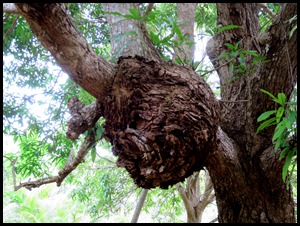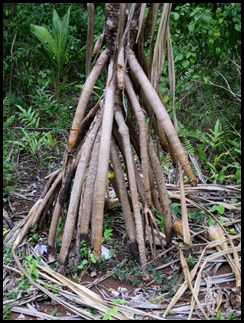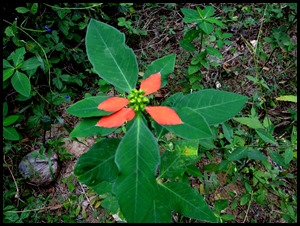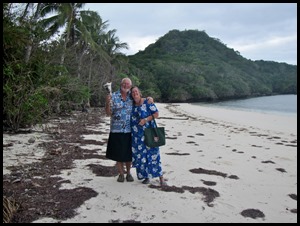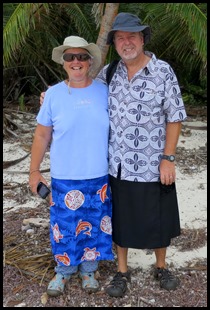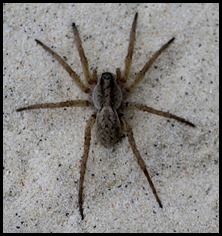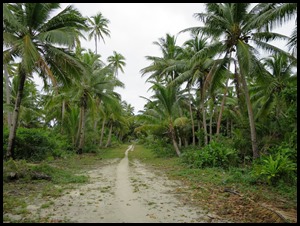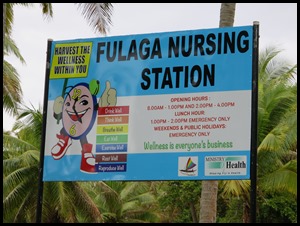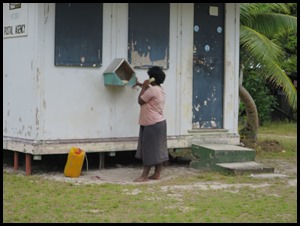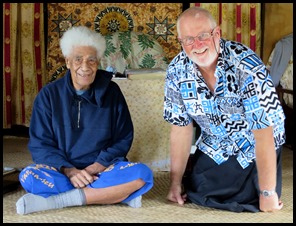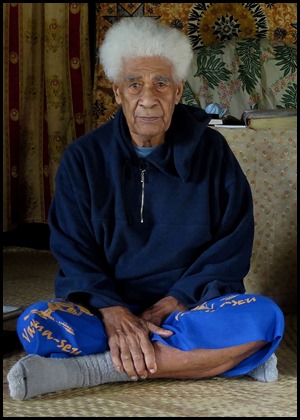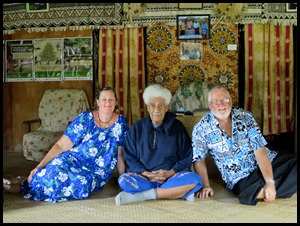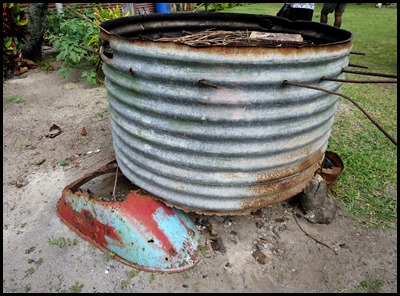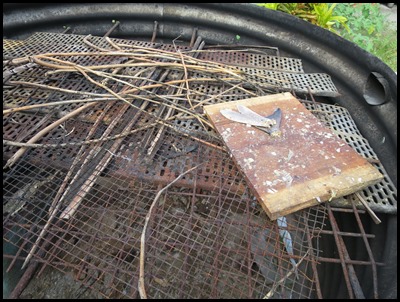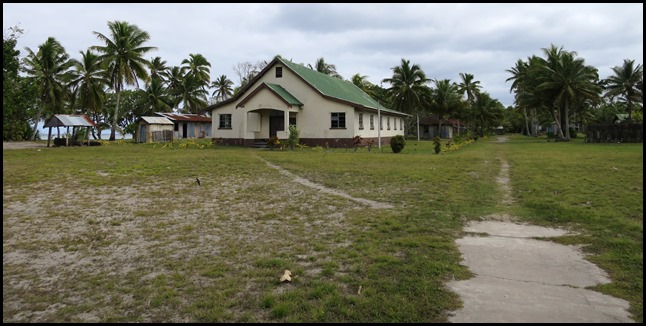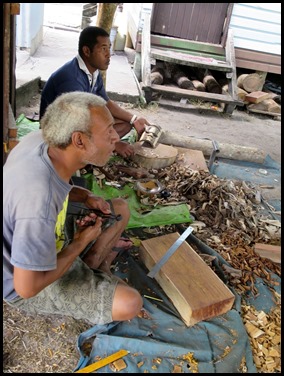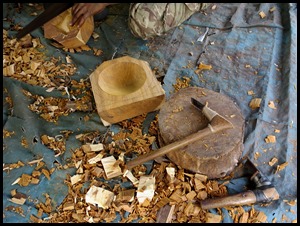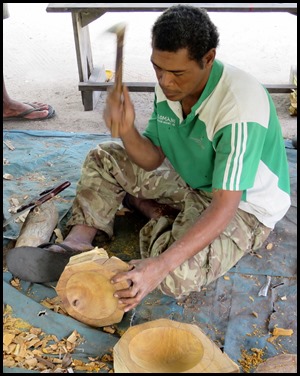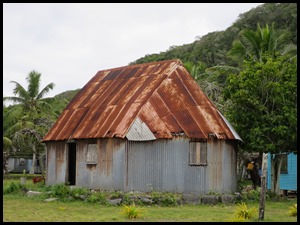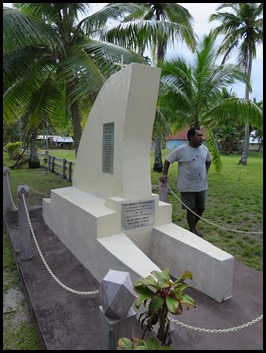Fulaga Sevusevu

|
Ashore to Sevusevu with Chief
Daniel 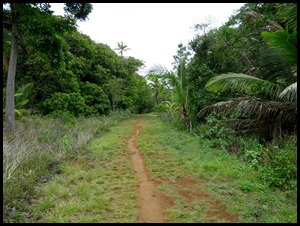 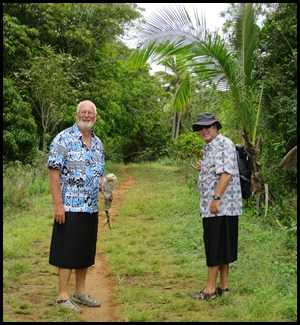 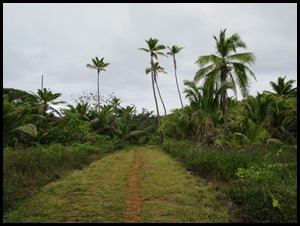 We jumped up refreshed after a good
nights sleep and arranged with Scott-Free to go ashore after breakfast
to offer sevusevu to the senior chief of the island and also of the primary
village of Moana-i-Cake, Fulaga. We left the dinghies on the small beach and
began the twenty minute walk to the village along the well
kept path. Bear and Steve both looked the part
in their sulas and shirts, Bear is seen clutching his bunch of yoqona or kava to
hand over at the appropriate time. On we
went.
Wiki Says:-
Fulaga (pronounced [fuˈlaŋa])
(proper name: Vulaga) is a
crescent-shaped reef-limestone island
in Fiji's
Southern Lau
Group.
Geography: it
covers an area of 18.5 square kilometres. It has a maximum elevation of 79
metres. The limestone belongs to the Koroqara Limestone (Tokalau Limestone
Group) and is probably Late Miocene in age. In form it is a basin which has been
breached in the north, flooding the interior, which has many islets and rocks.
The island thus has this unique, beautiful lagoon that adequately supplies the
inhabitants with different varieties of fish and sea shells. There are three
terrace levels, two with maximum elevations 55 m and 40 m, the third being
lower. There is an elevated notch 2 m above mean sea
level.
Demographics:
There are three villages, Muanaicake, Muanaira and Naividamu. Total population
was almost 600 in the middle 20th century but is now less than 400, due to
migration to the mainland for secondary school education for children, and
employment for parents.
In
Tradition: The people are
traditional carvers, skilled in the making of outrigger canoes and 'tanoa' (or
'kumete' in their dialect) which are wooden bowls carved out of local hardwood
and used in formal and informal Yaqona Ceremonies and social gatherings across
Fiji.
 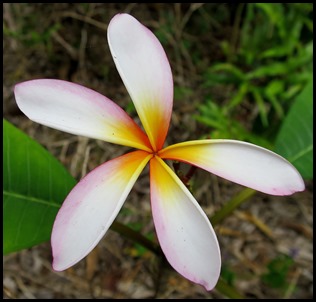 Along the way we stopped by a baby frangipani tree with a single bloom.
A wonderful burl on a tree, a stilted palm and a baby poinsettia. Honeyeaters and kingfishers along with swifts and finches kept the walk interesting. We saw small clouds of black butterflies with white dots but all attempts by Bear with his expert whispering failed to get them to sit and pose as a group.
We saw a beach and took a small detour, it would be a scene from Robinson Crusoe had there not been all the seaweed and coconut leaves but we posed. Maj and skipper, aka Chris and Steve posed too. I went over to talk to this chap on the beach as it was an unusual sight, then remembered my current mistrust of bideys since my last encounter bit me.........and I bear the scar........forever.
On we went, more coconut trees along this stretch of the path. Then our first house to our left – we later found out was where single men live a ‘dormitory lifestyle’. Next was the health centre complete with fun sign and next door the phone box. We chatted to a couple of villagers and told them we would like to offer sevusevu and were soon scooped up by a machete wielding Sokei. He had been en route to do some tree felling but was happy to become our unofficial guide.
We entered the village proper, I randomly took this picture of a typical house, not knowing this would be our family home once we had been ‘adopted’. This is the way here, as soon as the chief gave us his blessing to be part of his world – protection, and permission for anchoring, fishing, swimming and visiting, we would be allotted a family.
Sokei nipped into his house to quickly put a sarong over his shorts, we were bade to leave our shoes outside and then we were presented to Chief Daniel, a sprightly and friendly eighty nine year old. He said “Bula, Vinaka” and he gestured to sit on the mat facing him. To his right was Moses, an elder responsible for the guest book and taking FJ$50 from each visiting boat – this goes toward the village funds. Sokei took our bundles of kava and in Fijian welcomed us, asked the chief our permissions and Chief Daniel responded. We then asked Sokei if there were any restrictions we should observe and the only taboos were a couple of places we should not fish but the main thing is to respect the environment. I couldn’t help my mind wandering as I listened, feet tucked to the side, hand getting pins and needles that Chief’s dad – probably, and the chief’s grandpa – definitely, would have been preparing to eat us.......... We have since spoken to various islanders about this very topic, it is in their past, just as we have dodgy doings in our history but it does make for interesting reading and there are many graphic stories on the web. No kava was offered to us, I for one was not unhappy and thought ‘got away with that’.
Ceremony and photo shoot over, Sokei took us on a tour of the village beginning with this fish smoker.
The Church dominates the centre of the village and we would learn that if an medical emergency occurred with enough time for treatment, a helicopter from the mainland can land here. Clearly, there are accidents where there is no time and Sarah the nurse just has to do her best.
Next stop was at one of three wood working areas. Despite basic tools the men we watched had all ten fingers and the finished kava bowls, turtles with lids and all manner of other items were smooth, polished and rather fine. Woodcarving is the islanders main source of income. The chap on the right, Billy, we would be formally introduced to as the chiefs-sisters-daughters-husband, and therefore part of our adoptive family.
Another example of a village house, there are fifty seven altogether. Sokei stopped by the Memorial to past Councillors who serve three years and are selected from the many islands nearby. A one carefully owned house showing that many islanders have upped and left to live elsewhere. If they return at a later date they will repair and carry on. We would learn that there are no vehicles on the island and water is collected by each house via guttering on two sides of the steep roof able to sustain storms. Some houses have plastic water butts but most have concrete ones. In the middle of the village there was a huge concrete collecting tank for those that run short. Each house has two medium sized solar panels provided by the Government that cost them six pounds a month, a battery and an inverter to turn the 12v power into 240v to power lighting. No one has a fridge or a freezer, the school has a television and a few have mobile telephones. Those with internet ability have to get on the ferry that takes four days to get to Suva to collect their emails........... We saw some chickens running around but when we asked about eggs, the cunning ladies like to hide where they lay. Everyone knows who owns who, but we were pleased not to have to identify them as many looked identical to our untrained eye. The cargo boat come once a month with supplies, the island grows cassava and coconuts but the main diet is fish. At this point Sokei took us to our family and Maj and Steve to theirs. Our house, the green one above was headed up by grandma, the chiefs sister. two daughters live in Suva, two nearby, Nettie [another daughter] lives here with Billy and their two children. Nettie’s nephew Aquilla, was our translator as none of the family speaks English. This was a bit of a disadvantage but we managed. Grandma poured lemon tea and served us first with a delicious roti and followed it up with pancakes. What was left was packaged up for us to take home. Tomorrow, Saturday is a day of hard work to get everything done for many church services and a day of rest on Sunday. We were invited to ten o’clock mass and lunch with the family afterward. Sunday. The singing in church was lovely but a very persistent man on the triangle made it a bit heavy going, apparently this is the norm for the Lau Group. At home, after mass, we sat on the floor, were given knife and fork and told to help ourselves to korma, salted roast pork, fish, tortillas and cassava. The family ate with their hands and used a bowl of water to wash their fingers between handling of the different dishes. Billy left as soon as he had finished eating to rest. The ladies left to wash up and rest, so we bade our thanks through Aquilla and went back to Beez. Maj and I will come back at ten in the morning for weaving lessons from grandma and the boys to learn woodcarving.
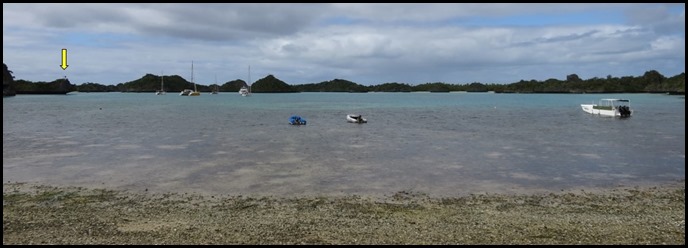
By the time we got back to Baby Beez the tide had gone out but a kind person had walked both the ladies out into ‘floating range’. We went for a spuddle and then home to Beez - parked under the yellow arrow.

.
ALL IN ALL ANOTHER WORLD - SIMPLE, HOMELY AND HAPPY A VERY FRIENDLY PLACE
|
